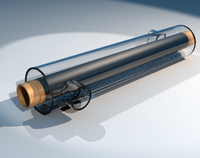
Photo from wikipedia
Abstract A liquid drop levitates on its own vapor on a sufficiently hot surface (the Leidenfrost effect). Application of an electrical potential difference across the vapor gap suppresses the Leidenfrost… Click to show full abstract
Abstract A liquid drop levitates on its own vapor on a sufficiently hot surface (the Leidenfrost effect). Application of an electrical potential difference across the vapor gap suppresses the Leidenfrost state via electrostatic attraction of liquid towards the surface. The resultant transient solid–liquid contacts significantly reduce the thermal resistance to heat transfer across the insulating vapor gap. This work is an indepth study on the heat transfer enhancement accompanying electrostatic suppression of the Leidenfrost state. A purely analytical model is developed to predict the heat transfer enhancement based on the transient wetting dynamics observed during suppression. This model is based on semi-infinite conduction heat transfer coupled with a physics-based prediction of the voltage-dependent wetted fraction. The model is strongly validated by comparison with inhouse experiments and related experimental data from literature. These experiments measure the heat transfer enhancement associated with electrostatic suppression of the Leidenfrost state for three fluids, at various applied voltages and superheats. The experimentally-validated model predicts that heat transfer enhancement scales as the square of the wetted fraction. Results show a 4X enhancement in heat transfer by electrostatic suppression of the Leidenfrost state of water droplets; higher enhancements are measured for organic solvents.
Journal Title: International Journal of Heat and Mass Transfer
Year Published: 2020
Link to full text (if available)
Share on Social Media: Sign Up to like & get
recommendations!